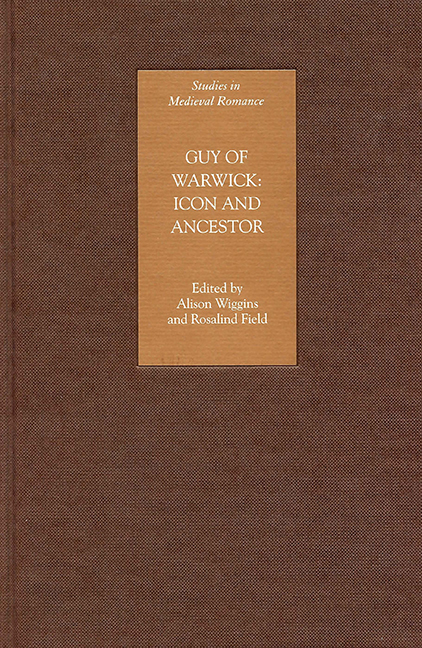Book contents
- Frontmatter
- Contents
- Illustrations
- Contributors
- Abbreviations
- Dedication
- Editorial Introduction: Namoore of this! How to read Guy of Warwick and why
- 1 Gui de Warewic at Home and Abroad: A Hero for Europe
- 2 Gui de Warewic in its Manuscript Context
- 3 Guy of Warwick as a Translation
- 4 From Gui to Guy: The Fashioning of a Popular Romance
- 5 The Manuscripts and Texts of the Middle English Guy of Warwick
- 6 The Speculum Guy de Warwick and Lydgate's Guy of Warwick: The Non-Romance Middle English Tradition
- 7 An Exemplary Life: Guy of Warwick as Medieval Culture-Hero
- 8 The Visual History of Guy of Warwick
- 9 ‘In her owne persone semly and bewteus’: Representing Women in Stories of Guy of Warwick
- 10 Of Dragons and Saracens: Guy and Bevis in Early Print Illustration
- 11 Guy of Warwick and The Faerie Queene, Book II: Chivalry Through the Ages
- 12 Guy as Early Modern English Hero
- Appendix: Synopsis of the Guy of Warwick narrative
- Index
11 - Guy of Warwick and The Faerie Queene, Book II: Chivalry Through the Ages
Published online by Cambridge University Press: 24 October 2017
- Frontmatter
- Contents
- Illustrations
- Contributors
- Abbreviations
- Dedication
- Editorial Introduction: Namoore of this! How to read Guy of Warwick and why
- 1 Gui de Warewic at Home and Abroad: A Hero for Europe
- 2 Gui de Warewic in its Manuscript Context
- 3 Guy of Warwick as a Translation
- 4 From Gui to Guy: The Fashioning of a Popular Romance
- 5 The Manuscripts and Texts of the Middle English Guy of Warwick
- 6 The Speculum Guy de Warwick and Lydgate's Guy of Warwick: The Non-Romance Middle English Tradition
- 7 An Exemplary Life: Guy of Warwick as Medieval Culture-Hero
- 8 The Visual History of Guy of Warwick
- 9 ‘In her owne persone semly and bewteus’: Representing Women in Stories of Guy of Warwick
- 10 Of Dragons and Saracens: Guy and Bevis in Early Print Illustration
- 11 Guy of Warwick and The Faerie Queene, Book II: Chivalry Through the Ages
- 12 Guy as Early Modern English Hero
- Appendix: Synopsis of the Guy of Warwick narrative
- Index
Summary
The 1590 edition of The Faerie Queene, comprising Books I to III, offers an engagingly complex response to native medieval romance and its related mythopoeic historical traditions. Not surprisingly, given its popularity and numerous literary and iconographical manifestations by the late sixteenth century, Guy of Warwick is a key text in that response. Spenser's engagement with Guy throughout Book II of The Faerie Queene seems to be part of a conscious programme in the 1590 text: signalling at various stages his roots in medieval English romance, he seeks to provoke his readers into recognition and consideration of the nature of his adaptations. The reader is encouraged to hold in mind a weighty native tradition in which providential worlds, pretensions to historicity, and topographical familiarity typically coincide. Like The Faerie Queene itself, this tradition could function rhetorically for both medieval and Early Modern readers as a ‘fayre mirrhour’ – a world both the same as and different from the viewer/reader's surrounding context. Remembering that tradition in the act of reading The Faerie Queene positions the reader close to the narrator, who unfolds the story with a comparable sense of literary and historical depth – ‘matter of iust memory’ (II.Proem.1). Eumnestes's chamber, or the room of ‘Good Memory’, visited in the Castle of Alma in Book II can be read as the library or bookish heritage out of which The Faerie Queene has been produced:
His chamber all was hangd about with rolls,
And old records from auncient times deriud,
Some made in books, some in long parchment scrolls. [II.ix.57]
But this room could also be an image of the reader's mind, the memory of literary tradition that must be brought to the task of reading The Faerie Queene. As Guyon the Knight of Temperance reads the book ‘Antiquitee of Faery lond’, he becomes an image of the reader, who should approach the poem with a similarly zealous commitment to memory and past literary traditions impinging on the present. Guyon reads ‘burning […] with feruent fire’ to gain understanding of his Elvish origins and his ‘countreys auncestry’ (II. ix.60). In the process, his reading becomes creative, almost authorial, since it produces in the following canto the text that we in turn read.
- Type
- Chapter
- Information
- Guy of Warwick: Icon and Ancestor , pp. 169 - 184Publisher: Boydell & BrewerPrint publication year: 2007

